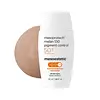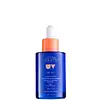What's inside
What's inside
 Key Ingredients
Key Ingredients

 Benefits
Benefits

 Concerns
Concerns

 Ingredients Side-by-side
Ingredients Side-by-side

Water
Skin ConditioningDibutyl Adipate
EmollientOctocrylene
UV AbsorberCyclopentasiloxane
EmollientHomosalate
Skin ConditioningBis-Ethylhexyloxyphenol Methoxyphenyl Triazine
Skin ConditioningAlcohol
AntimicrobialButyl Methoxydibenzoylmethane
UV AbsorberTitanium Dioxide
Cosmetic ColorantMethylene Bis-Benzotriazolyl Tetramethylbutylphenol
UV FilterCyclohexasiloxane
EmollientPEG-30 Dipolyhydroxystearate
EmulsifyingPolysilicone-15
UV FilterStyrene
PerfumingPEG-10 Dimethicone
Skin ConditioningSilica
AbrasiveBis-Ethylhexyl Hydroxydimethoxy Benzylmalonate
AntioxidantPolyamide-5
Skin ConditioningPotassium Azeloyl Diglycinate
Skin ConditioningJojoba Esters
EmollientHexyl Laurate
EmollientHelianthus Annuus Seed Oil
EmollientDimethicone
EmollientEthylhexylglycerin
Skin ConditioningAcacia Decurrens Flower Wax
EmollientPolyglycerin-3
HumectantPolyamide-3
Cetyl PEG/PPG-10/1 Dimethicone
EmulsifyingPolyglyceryl-4 Isostearate
EmulsifyingSodium Chloride
MaskingVp/Hexadecene Copolymer
Decyl Glucoside
CleansingDisteardimonium Hectorite
StabilisingDisodium EDTA
PEG-12 Allyl Ether
Hydrogenated Lecithin
EmulsifyingPropylene Glycol
HumectantXanthan Gum
EmulsifyingPentaerythrityl Tetra-Di-T-Butyl Hydroxyhydrocinnamate
AntioxidantPhenoxyethanol
PreservativeParfum
MaskingCI 77492
Cosmetic ColorantCI 77491
Cosmetic ColorantCI 77499
Cosmetic ColorantWater, Dibutyl Adipate, Octocrylene, Cyclopentasiloxane, Homosalate, Bis-Ethylhexyloxyphenol Methoxyphenyl Triazine, Alcohol, Butyl Methoxydibenzoylmethane, Titanium Dioxide, Methylene Bis-Benzotriazolyl Tetramethylbutylphenol, Cyclohexasiloxane, PEG-30 Dipolyhydroxystearate, Polysilicone-15, Styrene, PEG-10 Dimethicone, Silica, Bis-Ethylhexyl Hydroxydimethoxy Benzylmalonate, Polyamide-5, Potassium Azeloyl Diglycinate, Jojoba Esters, Hexyl Laurate, Helianthus Annuus Seed Oil, Dimethicone, Ethylhexylglycerin, Acacia Decurrens Flower Wax, Polyglycerin-3, Polyamide-3, Cetyl PEG/PPG-10/1 Dimethicone, Polyglyceryl-4 Isostearate, Sodium Chloride, Vp/Hexadecene Copolymer, Decyl Glucoside, Disteardimonium Hectorite, Disodium EDTA, PEG-12 Allyl Ether, Hydrogenated Lecithin, Propylene Glycol, Xanthan Gum, Pentaerythrityl Tetra-Di-T-Butyl Hydroxyhydrocinnamate, Phenoxyethanol, Parfum, CI 77492, CI 77491, CI 77499
Water
Skin ConditioningDicaprylyl Carbonate
EmollientDiisopropyl Adipate
EmollientIsostearyl Neopentanoate
EmollientEthylhexyl Salicylate
UV AbsorberPhenylbenzimidazole Sulfonic Acid
UV AbsorberBis-Ethylhexyloxyphenol Methoxyphenyl Triazine
Skin ConditioningIsododecane
EmollientDiethylamino Hydroxybenzoyl Hexyl Benzoate
UV FilterC12-15 Alkyl Benzoate
AntimicrobialCetyl PEG/PPG-10/1 Dimethicone
EmulsifyingGlycerin
HumectantMethylene Bis-Benzotriazolyl Tetramethylbutylphenol
UV FilterCetyl Dimethicone
EmollientLauryl PEG/PPG-18/18 Methicone
Skin ConditioningAcrylates/C12-22 Alkyl Methacrylate Copolymer
Phenyl Trimethicone
Skin ConditioningEthylhexyl Triazone
UV AbsorberSodium Chloride
MaskingStearalkonium Hectorite
Gel FormingOryza Sativa Bran Cera
Skin ConditioningSodium Hydroxide
BufferingSaccharide Isomerate
HumectantPhenoxyethanol
PreservativeTocopheryl Acetate
AntioxidantSimmondsia Chinensis Seed Oil
EmollientHydroxyacetophenone
AntioxidantPanthenol
Skin ConditioningMica
Cosmetic ColorantDecyl Glucoside
CleansingArginine
MaskingParfum
MaskingLauryl Glucoside
CleansingPropylene Carbonate
SolventBenzyl Alcohol
PerfumingEthyl Linoleate
EmollientDisodium Lauryl Sulfosuccinate
CleansingDunaliella Salina Extract
Skin ConditioningTerminalia Ferdinandiana Fruit Extract
AntioxidantPropylene Glycol
HumectantXanthan Gum
EmulsifyingCitric Acid
BufferingPantolactone
HumectantSodium Citrate
BufferingTocopherol
AntioxidantTin Oxide
AbrasiveGeraniol
PerfumingCitronellol
PerfumingLinalool
PerfumingEugenol
PerfumingCI 77891
Cosmetic ColorantWater, Dicaprylyl Carbonate, Diisopropyl Adipate, Isostearyl Neopentanoate, Ethylhexyl Salicylate, Phenylbenzimidazole Sulfonic Acid, Bis-Ethylhexyloxyphenol Methoxyphenyl Triazine, Isododecane, Diethylamino Hydroxybenzoyl Hexyl Benzoate, C12-15 Alkyl Benzoate, Cetyl PEG/PPG-10/1 Dimethicone, Glycerin, Methylene Bis-Benzotriazolyl Tetramethylbutylphenol, Cetyl Dimethicone, Lauryl PEG/PPG-18/18 Methicone, Acrylates/C12-22 Alkyl Methacrylate Copolymer, Phenyl Trimethicone, Ethylhexyl Triazone, Sodium Chloride, Stearalkonium Hectorite, Oryza Sativa Bran Cera, Sodium Hydroxide, Saccharide Isomerate, Phenoxyethanol, Tocopheryl Acetate, Simmondsia Chinensis Seed Oil, Hydroxyacetophenone, Panthenol, Mica, Decyl Glucoside, Arginine, Parfum, Lauryl Glucoside, Propylene Carbonate, Benzyl Alcohol, Ethyl Linoleate, Disodium Lauryl Sulfosuccinate, Dunaliella Salina Extract, Terminalia Ferdinandiana Fruit Extract, Propylene Glycol, Xanthan Gum, Citric Acid, Pantolactone, Sodium Citrate, Tocopherol, Tin Oxide, Geraniol, Citronellol, Linalool, Eugenol, CI 77891
Ingredients Explained
These ingredients are found in both products.
Ingredients higher up in an ingredient list are typically present in a larger amount.
You might know this ingredient as Tinosorb S or Bemotrizinol. It is a UV filter that covers both UVA and UVB rays.
This ingredient has two peak UV absorption peaks ( 310 and 340 nm) and is able to absorb both UV-A and UV-B rays. This ingredient works by preventing UV rays from reaching and damaging your skin.
On top of that - it is highly photostable and helps prevent the photodegration of other sunscreen ingredients such as avobenzone.
Tinosorb S is allowed in the EU, Australia, and Asia. It is close to being approved by the FDA and we'll hopefully get this ingredient in the U.S. by late 2025.
Fun fact: Tinosorb S is the most effective UV absorber at maximum concentration (measured by SPF) permitted in the EU.
This ingredient is oil-soluble, so your oil-cleansers will take this right off at night.
Learn more about Bis-Ethylhexyloxyphenol Methoxyphenyl TriazineThis ingredient is a high molecular weight silicone. It has emulsifying and skin conditioning properties.
Decyl Glucoside is a glucose-based surfactant and emulsion stabilizer. It is created by reacting glucose with the fatty acids from plants.
Surfactants help clean the skin by trapping oil, sebum, and dirt to be washed away. As an emulsion stabilizer, it stabilizes the ingredients in a product by preventing them from separating.
This ingredient is biodegradable and non-toxic. This ingredient is commonly found in baby shampoos.
Decyl Glucoside is sometimes used to stabilize the UV filter Tinosorb.
Learn more about Decyl GlucosideMethylene Bis-Benzotriazolyl Tetramethylbutylphenol (Tinosorb M) is a hybrid and broad-spectrum UV ingredient. It is both a UV absorber and filter.
UV absorbers are an agent that absorbs UV rays. They protect your skin by using chemical reactions to convert UV rays into heat and energy. UV filters physically reduce the amount of UV rays from reaching your skin.
Tinosorb M covers a range of 280-400 nm and is photostable. This ingredient is neither oil or water soluble.
Tinosorb M is not available in the US. However, it is available in the EU and Asia.
It's sister, Tinosorb S, is set to be approved in the US by late 2025 (fingers crossed!).
Learn more about Methylene Bis-Benzotriazolyl TetramethylbutylphenolParfum is a catch-all term for an ingredient or more that is used to give a scent to products.
Also called "fragrance", this ingredient can be a blend of hundreds of chemicals or plant oils. This means every product with "fragrance" or "parfum" in the ingredients list is a different mixture.
For instance, Habanolide is a proprietary trade name for a specific aroma chemical. When used as a fragrance ingredient in cosmetics, most aroma chemicals fall under the broad labeling category of “FRAGRANCE” or “PARFUM” according to EU and US regulations.
The term 'parfum' or 'fragrance' is not regulated in many countries. In many cases, it is up to the brand to define this term.
For instance, many brands choose to label themselves as "fragrance-free" because they are not using synthetic fragrances. However, their products may still contain ingredients such as essential oils that are considered a fragrance by INCI standards.
One example is Calendula flower extract. Calendula is an essential oil that still imparts a scent or 'fragrance'.
Depending on the blend, the ingredients in the mixture can cause allergies and sensitivities on the skin. Some ingredients that are known EU allergens include linalool and citronellol.
Parfum can also be used to mask or cover an unpleasant scent.
The bottom line is: not all fragrances/parfum/ingredients are created equally. If you are worried about fragrances, we recommend taking a closer look at an ingredient. And of course, we always recommend speaking with a professional.
Learn more about ParfumPhenoxyethanol is a preservative that has germicide, antimicrobial, and aromatic properties. Studies show that phenoxyethanol can prevent microbial growth. By itself, it has a scent that is similar to that of a rose.
It's often used in formulations along with Caprylyl Glycol to preserve the shelf life of products.
Propylene Glycol is an odorless, colorless liquid. As a humectant, it helps skin retain moisture. It also aids in delivering active ingredients.
Another role of this ingredient is preventing a product from melting or freezing. Propylene glycol also adds antimicrobrial properties to a product, elongating product lifespan.
This ingredient is considered an organic alcohol and commonly added into both cosmetics and foods.
Those with sensitive skin or conditions may develop a rash when using this ingredient.
Learn more about Propylene GlycolChances are, you eat sodium chloride every day. Sodium Chloride is also known as table salt.
This ingredient has many purposes in skincare: thickener, emulsifier, and exfoliator.
You'll most likely find this ingredient in cleansers where it is used to create a gel-like texture. As an emulsifier, it also prevents ingredients from separating.
There is much debate on whether this ingredient is comedogenic. The short answer - comedogenic ratings don't tell the whole story. Learn more about comegodenic ratings here.
The concensus about this ingredient causing acne seems to be divided. Research is needed to understand if this ingredient does cause acne.
Scrubs may use salt as the primary exfoliating ingredient.
Learn more about Sodium ChlorideWater. It's the most common cosmetic ingredient of all. You'll usually see it at the top of ingredient lists, meaning that it makes up the largest part of the product.
So why is it so popular? Water most often acts as a solvent - this means that it helps dissolve other ingredients into the formulation.
You'll also recognize water as that liquid we all need to stay alive. If you see this, drink a glass of water. Stay hydrated!
Learn more about WaterXanthan gum is used as a stabilizer and thickener within cosmetic products. It helps give products a sticky, thick feeling - preventing them from being too runny.
On the technical side of things, xanthan gum is a polysaccharide - a combination consisting of multiple sugar molecules bonded together.
Xanthan gum is a pretty common and great ingredient. It is a natural, non-toxic, non-irritating ingredient that is also commonly used in food products.
Learn more about Xanthan Gum